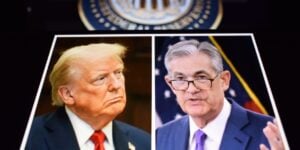For several decades the money we use in everyday life is “fiat currency.” That is, it is created by central banks and its value is not anchored to anything of intrinsic worth such as gold. The workings and decision making of central banks is therefore important, and does not need to be a subject of great mystery. At its most basic level, a central bank is simply a balance sheet and monetary policymakers make decisions about the size and composition of either the asset (sources) side or liability (uses) side of the balance sheet.
Sources and Uses of Central Bank Money
In the original toolkit of monetary policies, the only instrument designed to affect the uses of central bank money was the discretionary administration of minimum reserve requirements imposed on commercial banks. The notion was that for a given amount of central bank money, policymakers could increase the amount that commercial banks were required to hold idle in their reserve deposits, producing a restrictive impulse on the banking system. That tool fell into disuse and was entirely abolished at most major central banks, leaving only actions that affected the quantity or composition of sources of central bank money in the mix of policy actions available to decision makers. The desperate adoption of quantitative easing (QE) in the wake of the “global financial crisis” (GFC) in 2008 was a massive operation to flood the financial system with new sources of central bank money in what turned out to be futile efforts to jump-start commercial bank lending for anything and everything that could pass muster with prudential supervisors. The only other actions taken by US monetary policymakers on the sources of base money was an equally futile “operation twist” conducted in late 2011 and in 2012.[1]
The aim of the twist operations was to lengthen the maturity/duration of the central bank’s portfolio of earning assets by selling short-term securities and buying an equal amount of long-term securities. The theory was that such transactions would cause a reduction in other long-term borrowing costs and consequently result in more borrowing and spending by businesses as well as some households. Of course, the simultaneous effect was to shorten the maturity/duration of the government’s net debt held by the private sector. One accounting effect was to increase the net interest income of the central bank, and consequently raise additional “other income” of the government because the central bank would now remit greater surplus income to the Treasury. While this near-term reduction in the net interest expense on the government’s outstanding debt had marginal budgetary effects, it is not clear from the experience that it had any effect on the aggregate economy. Either way, although the decision was taken by monetary authorities, this was a fiscal decision executed through the central bank’s balance sheet, with no clear monetary implications.
New Tools
The new tools introduced since the GFC operate on the uses side of the central bank balance sheet. After QE ballooned the stock of central bank money to massive size, further actions in that direction—at least in the US—were not viewed as potentially effective. Congress authorized one new tool–the payment of interest or reserve balances (IOR)–in the midst of the GFC, and in 2014 the policymakers announced the intent to employ “reverse repurchase agreements” (RRPs) as a companion instrument for affecting the composition of liabilities on the central bank balance sheet.[2]
Changes in the IOR are intended to set a floor under short-term market interest rates. The idea is that commercial banks would not lend to other borrowers at a rate below that available on riskless and highly liquid deposits at the central bank. Of course, in a global and highly dollarized world economy, there are many other lenders/investors who do not have reserve accounts at the US central bank and have reasons to hold low risk and highly liquid assets denominated in US dollars, and may be willing to accept yields below the rate paid by the central bank. To supplement IOR, reverse repurchase agreements (RRPs) created a way for the central bank to borrow from both domestic and foreign money market mutual funds, government sponsored enterprises (GSEs), and a few other non-commercial bank participants in global financial markets. The stated objective of both tools is to influence other interest rates—the “price of credit” channel for transmitting the decisions of policymakers to the real economy.
However, IOR is also intended to give an incentive for commercial banks to hold “idle” deposits at the central bank rather than make loans or buy securities which would create deposit money and convert “excess” reserves into “required” reserves. RRPs affect the portion of central bank money available as commercial bank reserves; funds lent to the central bank via RRPs are “absorbed” as a use of base money, and consequently shrink the volume of reserves “available” to commercial banks. Theoretically, auctions of RRPs in sufficient volume could absorb all “excess” reserve balances, putting commercial banks in a “reserve constrained” position similar to the operating environment prior to the GFC.[3] (Greenwood, Hanson and Stein 2016).
Whether or not policy decisions to influence the composition of the uses of central bank money with these tools would result in effective monetary impulses is not known. There has been too little experience to draw firm conclusions about their efficacy. However, the fiscal implications are quite clear. Payments to reserve-balance holders reduce the surplus net interest income of the central bank, so less is turned over to the Treasury. That is, higher IOR reduces government revenue and increases the budget deficits. Similarly, lenders to the central bank under the RRP program—mostly GSEs and both domestic and foreign money market mutual funds—earn income at the expense of taxpayers. Interest paid by the central bank on RRPs (including foreign official accounts) also reduces the residual earnings of the central bank which are remitted to the Treasury.
The net economic implications for the macro economy are ambiguous; higher IOR and rates on RRPs are intended to be restrictive impulses. However, for economic analysts who view larger fiscal deficits to be expansionary impulses, there is a mitigating or offsetting effect on the stance of fiscal conditions[4] (Sims 2016). Because there is no empirical history on which to base policy prescriptions using these tools, neither the administered yields set by policymakers nor the volumes of reserve balances affected can be used as reliable targets or indicators of the thrust of policies on aggregate economic activity.
[1] http://www.federalreserve.gov/faqs/money_15070.htm
[2] http://www.federalreserve.gov/monetarypolicy/overnight-reverse-repurchase-agreements.htm
http://www.federalreserve.gov/monetarypolicy/overnight-reverse-repurchase-agreements.htm
https://www.newyorkfed.org/markets/opolicy/operating_policy_151216.html
http://www.federalreserve.gov/econresdata/feds/2015/files/2015010pap.pdf
[3] Greenwood, Hanson and Stein advocate greatly expanded use of RRPs as a monetary policy tool and also as a vehicle for satisfying the new and higher mandates to meet “liquidity coverage ratios.”
[4] This is not a straw man; see https://www.kansascityfed.org/~/media/files/publicat/sympos/2016/econsymposium-sims-paper.pdf?la=en
“Reductions in interest rates can stimulate demand only if they are accompanied by effective fiscal expansion. For example, if interest rates are pushed into negative territory, and the resources extracted from the banking system and savers by the negative rates are simply allowed to feed through the budget into reduced nominal deficits, with no anticipated tax cuts or expenditure increases, the negative rates create deflationary, not inflationary, pressure.”





